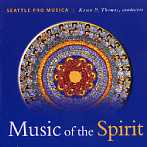There’s some very fine singing on this CD, not surprising given the experience and reputation of the Seattle Pro Musica. Although they’ve chosen what seems a random selection of sacred works, albeit covered by the aptly inclusive disc title, the program boasts a uniformity of sound and interpretive spirit that creates a comfortable, satisfying listening context. While it may be odd to hear Allegri’s famed Miserere together with Stanford’s equally beloved motet–and especially juxtaposed with Wolf’s hyperbolic romanticism in the Six Sacred Songs–it’s a joy to hear this expert performance of Frank Martin’s Mass for Double Choir (which, whether coincidental or not, contains intriguing similarities to Vaughan Williams’ Mass, also for double choir a cappella, written at exactly the same time–1922).
But the best reason to own this disc is for Seattle Pro Musica director Karen P. Thomas’ Lux Lucis, a set of three motets for women’s voices that draws on texts by Hildegard von Bingen. And although the style occasionally suggests the influence of chant, and some of the harmonic structures owe something to early music forms, these works are entirely original, conceived by a composer who absolutely knows her material–various treatments of the theme of “light”–and her medium. The choral writing is first-rate, employing a range of techniques, including cluster effects, irregular or indeterminate rhythms, close dissonances, chords that sequentially form, then contract, then expand, unusual voicings, rhythmic chanting with harmonies reminiscent of Eastern European styles, and a method of imitation/echoing that creates wonderfully colorful, vibrant sound. These are important works that, although quite challenging, should be in the repertoire of every capable women’s choir–and they’re sung here with impeccable technique and ensemble tuning and balance.
The acoustic is very resonant–and this works okay for some pieces, including Lux Lucis and the Mass, but not so well for the dense chromatic textures of the Wolf. The Allegri also sounds fine–the engineers did a good job to balance the solo quartet with the rest of the choir–and the voices are excellent. However, as with most choirs, even the professional ones, the piece’s length and taxing vocal demands take their toll on intonation well before the last verse. But it’s not a major problem–and overall this is a very worthy effort that deserves attention by serious choral fans, especially the Lux Lucis!
































